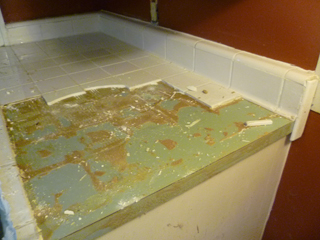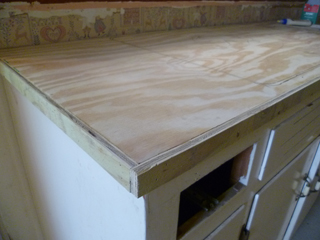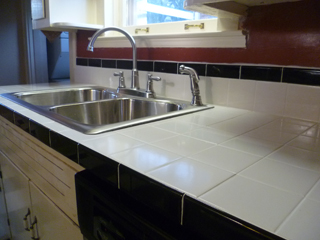 As part of a kitchen renovation last week in Madison (see this post), I was asked to redo some tile counters as well as the floor. The counters would consist of mainly basic white square tiles, framed with black around the edges.
As part of a kitchen renovation last week in Madison (see this post), I was asked to redo some tile counters as well as the floor. The counters would consist of mainly basic white square tiles, framed with black around the edges.
Like the old floor tiles, the previously tiled counter was not holding up well. The homeowner claimed that once in a while the tiles would just come off in her hand. Not good. The reason for this is also similar to the floor’s problems- the tile was inadequately installed with some sort of adhesive that just didn’t bond the tiles well. When the adhesive was spread it did not make much contact between the two surfaces, leaving lots of extra space under the tile. This is a problem, especially around the sink where these voids can fill with moisture and lead to fungal growth… yuck!
 So, I ripped out the old countertops. You can see in the picture that the tile was actually applied over an old laminate countertop. Also NOT a good idea. Laminate is popular for counters becuase it’s easy to clean and stains don’t stickto it, right? Why would you suddenly expect tiles to stick to it? They didn’t. With just a little leverage they came off it large sheets. Turns out the grout was holding them together as much as the adhesive. Time for a new countertop.
So, I ripped out the old countertops. You can see in the picture that the tile was actually applied over an old laminate countertop. Also NOT a good idea. Laminate is popular for counters becuase it’s easy to clean and stains don’t stickto it, right? Why would you suddenly expect tiles to stick to it? They didn’t. With just a little leverage they came off it large sheets. Turns out the grout was holding them together as much as the adhesive. Time for a new countertop.
 I built the base for the new countertop out of 3/4″ plywood. I attached strips of 1/2″ plywood under this wherever the top would rest on the cabinets. This makes the counter a little taller. On top of this I installed 1/2″ Hardibacker cementboard over a bed of thinset. With the tile installed the entire counter would end up just shy of 2 inches thick. This is important because those black edge tiles that go around the perimeter are 2″ tall. I wanted to have plenty of support for those so they didn’t ‘hang over’ too much.
I built the base for the new countertop out of 3/4″ plywood. I attached strips of 1/2″ plywood under this wherever the top would rest on the cabinets. This makes the counter a little taller. On top of this I installed 1/2″ Hardibacker cementboard over a bed of thinset. With the tile installed the entire counter would end up just shy of 2 inches thick. This is important because those black edge tiles that go around the perimeter are 2″ tall. I wanted to have plenty of support for those so they didn’t ‘hang over’ too much.
 A tile countertop can be a great alternative to other types of counters because they are custom-made for the space and you can basically put together any design that you can dream up.
A tile countertop can be a great alternative to other types of counters because they are custom-made for the space and you can basically put together any design that you can dream up.









